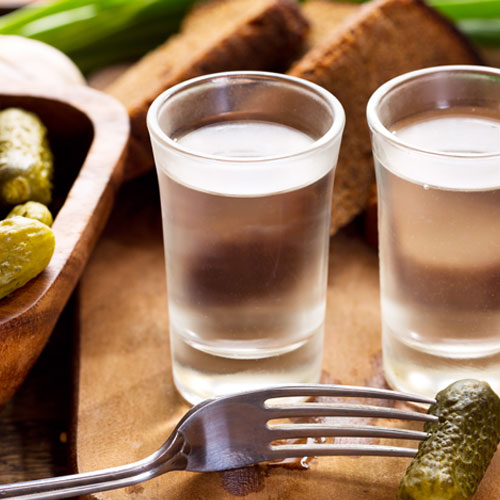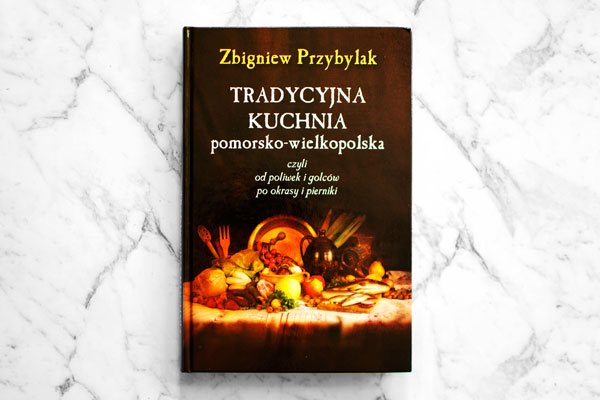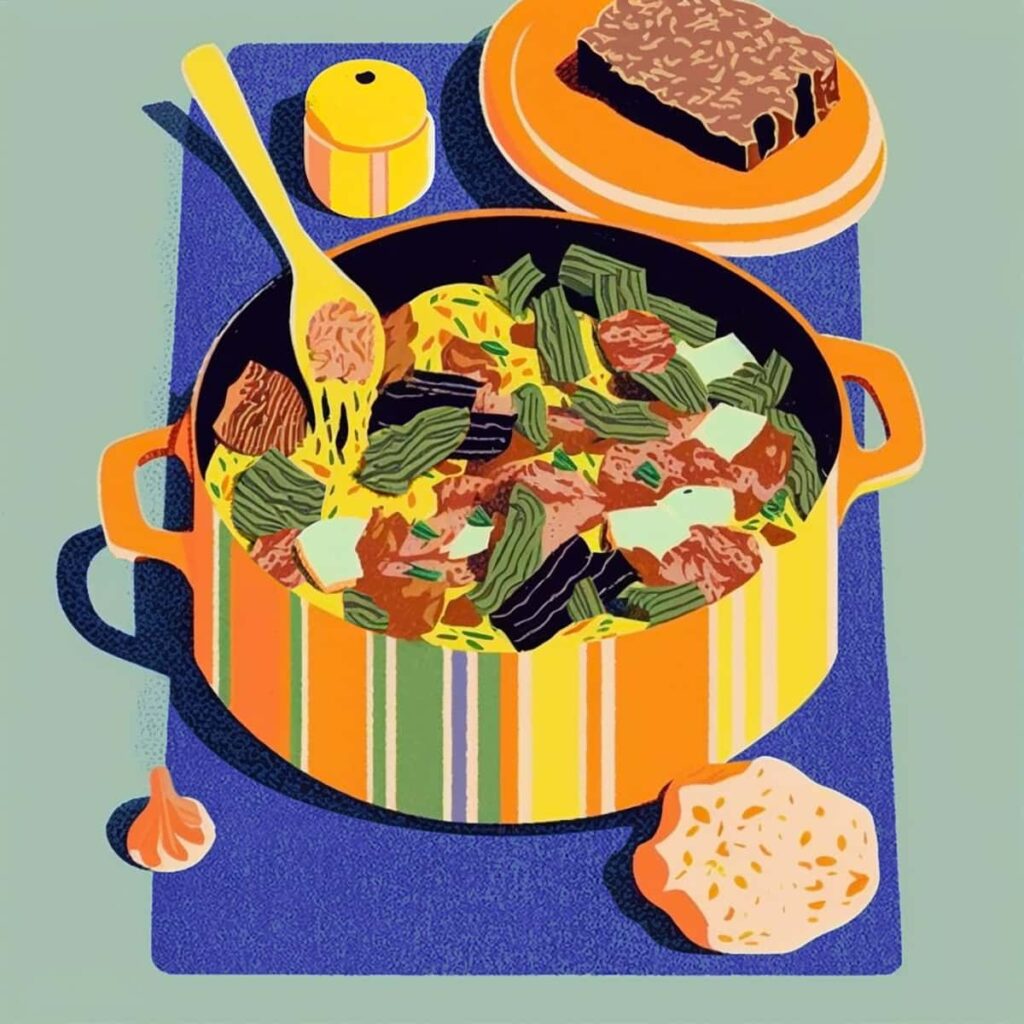I Tried Nearly Every Polish Candy. Here Are the Best of the Best.
Indulge yourself in the sweet and fascinating world of classic Polish sweets. From fruity hard candies to creamy fudges, these treats have been satisfying sweet-tooth cravings for generations.
But it’s not just the taste that makes them special – each candy carries a unique history that speaks to Polish culture and traditions.
Join me as I take a journey through the rich and delicious world of classic Polish confectionery, exploring what makes them so beloved and enduring.
Top 10 Most Popular Polish Sweets you have to try
Ptasie Mleczko® (aka ‘the Bird’s Milk’)
Pron.: pta-shea mlech-koh
Manufacturer: E. Wedel (Lotte)
Alternative brands: ‘Opolanki’ (Odra), ‘Alpejskie Mleczko’ (Mondelēz), ‘Królewskie Mleczko’ (Wawel) and others
There is no doubt that ‘Ptasie Mleczko’ is one of Poland’s most recognized confectioneries.
Each treat is a small, chocolate-covered bar filled with soft, marshmallow-like mousse. A single pack contains around three dozen bite-sized bars, perfect for sharing with family and friends.
Today, ‘Ptasie Mleczko’ can be enjoyed in a variety of flavours: from classic vanilla to lemon, caramel, cream and many more.
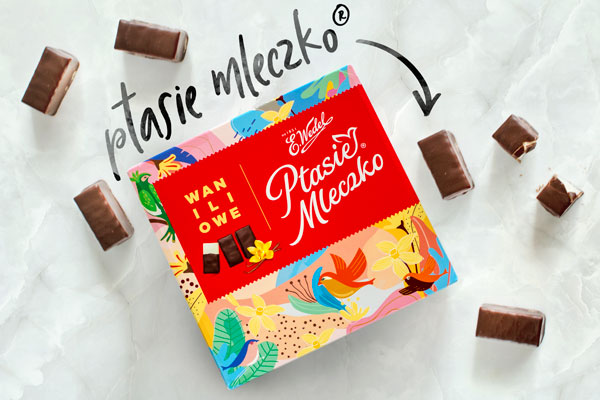
As Wedel’s chocolate maestro, Janusz Profus recounts, “in 1936, Varsovian chocolatier Jan Wedel came back from a trade show, inspired to create a brand new product. That event took place in the US, therefore it’s safe to assume what he saw were the marshmallows – made with egg whites, sugar and corn syrup.
Corn wasn’t as popular in Poland at that time, thus potato syrup was used instead. Wedel added Polish butter to the mix and that’s how the fluffy foam was born”.
‘Ptasie Mleczko’ was a 100% unique and innovative product. Each foam cube was bathed in the renowned Wedel chocolate, creating a sweet treat we all know and love today.
Unfortunately, when the factory fell under communist rule, its trademark wasn’t extended. The recipe was then “gifted” [cough cough] to a factory in the USSR, which started manufacturing it under the name ‘Ptice Malako’.
To prevent any confusion, since 2014 only E. Wedel products can trade in the EU under the name ‘Ptasie Mleczko’.
There are many copycats on the market, often named alike – such as ‘Alpejskie Mleczko’ (Milka) or ‘Królewskie Mleczko’ (Wawel) – but some would argue that nothing beats the original.
‘Ptasie Mleczko’ is available wherever sweets are sold, but if you’re looking to purchase a pack as a gift – consider visiting one of Wedel’s chocolate lounges. At times, they offer a selection of treats in premium decorative tin cans.
When shopping internationally, try enquiring at your local Polish deli. I’m yet to see a store that doesn’t carry at least one flavour on the regular basis.
Krówki
Pron.: croof-key; already plural
Manufacturers: OSM Opatów, Wytwórnia Cukierków L. Pomorski i Syn, ZPC Milanówek, Majami, Wawel, E. Wedel (Lotte) and others
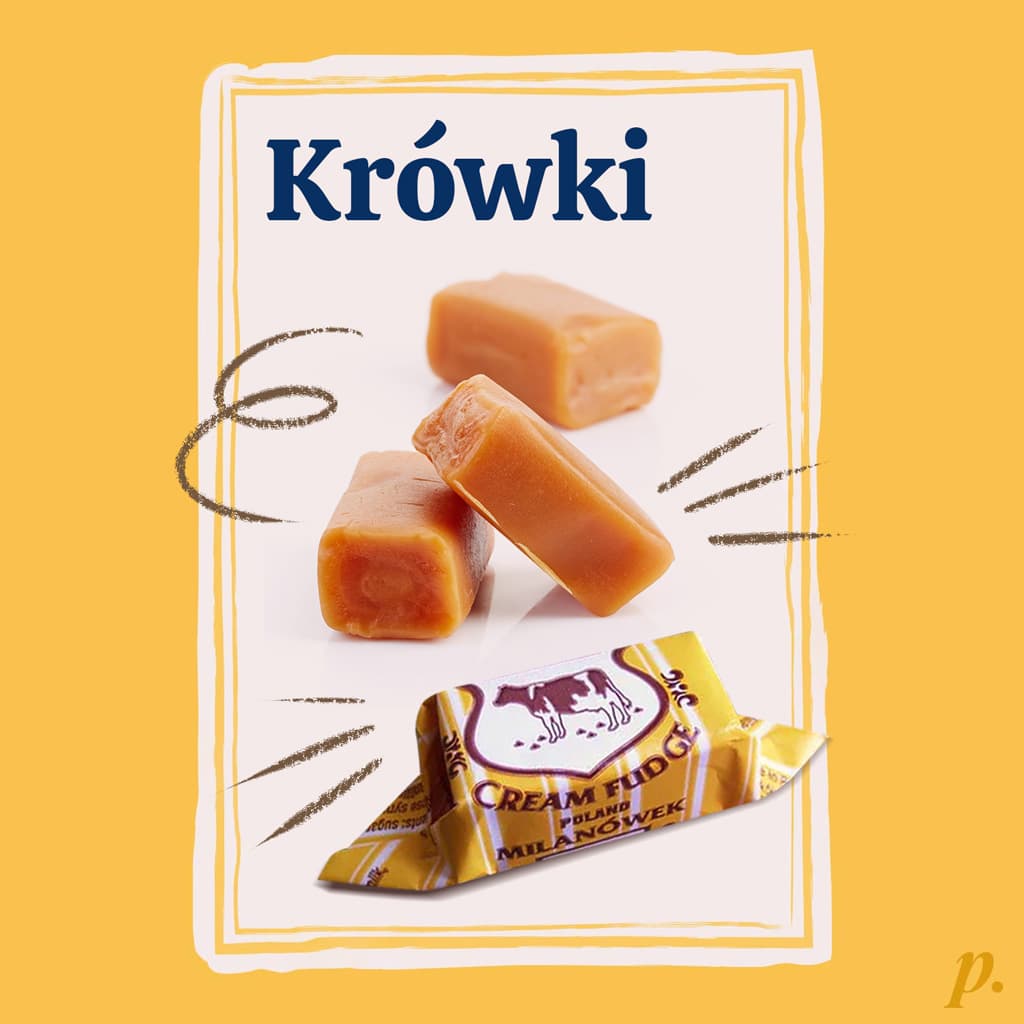
‘Krówki’, which means ‘tiny cows’ in Polish, are a beloved confectionery widely recognized across the world.
Produced by numerous companies in Poland, this dense, chewy fudge candy comes in mini-bars, each wrapped individually.
However, I find that there is a noticeable difference in quality between mass-produced and artisanal ‘Krówki’. While larger manufacturers tend to produce drier and harder candies, artisanal makers craft a fudge with a crispy exterior and a pleasantly soft, even stickjaw-y interior.
Despite these differences, both varieties have their dedicated fans. To discover your personal preference, it’s worth trying several brands; keep in mind, however, that ‘Krówki’ may harden over time. If you prefer a chewier texture, be sure to check the production date and choose the freshest batch available.
According to many sources, ‘Krówki’ fudge was first created in 1921 by Feliks Pomorski, who established a confectionery factory in Poznań. He produced delicious candies wrapped in packaging adorned with a cow image, hence the name. Following the outbreak of war in 1939, Pomorski relocated to Milanówek near Warsaw, where the company continues to produce candy to this day.
The process of making ‘Krówki’ fudge is relatively simple, yet requires significant experience. First, fresh whole milk is poured into a boiler, followed by the addition of sweet syrup and butter, which are then boiled together.
After cooking is complete, vanilla or other flavourings and salt are added. The resulting fudge mass is then poured onto specialized worktops, where it gradually cools and thickens.
Once sufficiently dense, the mass is cut into small pieces and individually wrapped. Some companies still perform this task by hand, as it is said to help preserve the candy’s soft and chewy texture.
It’s worth pointing out that the Polish Ministry of Agriculture has officially registered five regional varieties on its list of traditional products:
- ‘szczecinecka’ (from Szczecinek, list entry)
- ‘wyborowa bełchatowska’ (from Bełchatów, list entry)
- ‘opatowska’ (from Opatów, list entry)
- ‘regulicka’ (from Regulice, list entry)
- ‘mleczna strzyżowska’ (from Strzyżów, list entry)
When visiting Poland, keep an eye out for these regional delicacies.
Śliwki w Czekoladzie
Pron.: shleaf-key vchekola-gee-a; already plural
Manufacturers: Solidarność (Colian), Jutrzenka Dobre Miasto, Purple Valley, Wawel and others
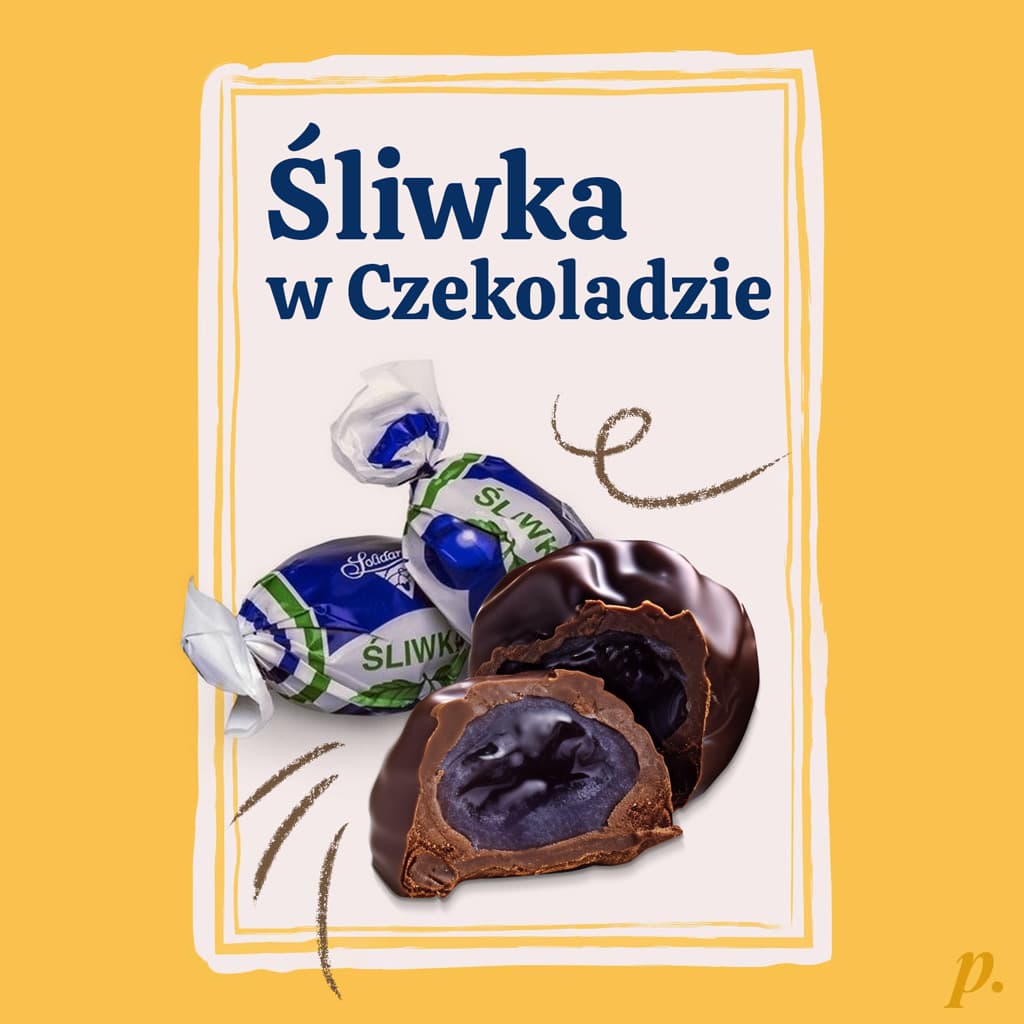
‘Śliwki w Czekoladzie’ are rich candies with a prune filling, covered in chocolate and individually wrapped. You can find them in boxes, bags, and decorative cans of various sizes.
This iconic Polish sweet has garnered a huge following both at home and abroad. The most well-known brand, ‘Śliwka Nałęczowska’, produced by the Solidarność chocolatier, has been continuously manufactured since 1964.
In 2018, a new regional brand called ‘Szydłowianka’ emerged on the market. This is exciting news, as the Szydłów region has a long history of fruit growing. Those were the very first fruit orchards planted on Polish soil, within the royal gardens and right by the monasteries. I can’t wait to give them a try.
You can find ‘Śliwki w Czekoladzie’ at most Polish grocers. However, with so many chocolate-covered prune brands out there, be sure to get the real deal. Some lower-end manufacturers use prune-flavoured filling rather than real dried fruit. If you’re shopping abroad, try asking at your local Polish deli.
Candy Caramels with Fillings
Irysy
Pron.: e-reesee; already plural
Manufacturers: Jutrzenka Dobre Miasto, Jedność-Grójec
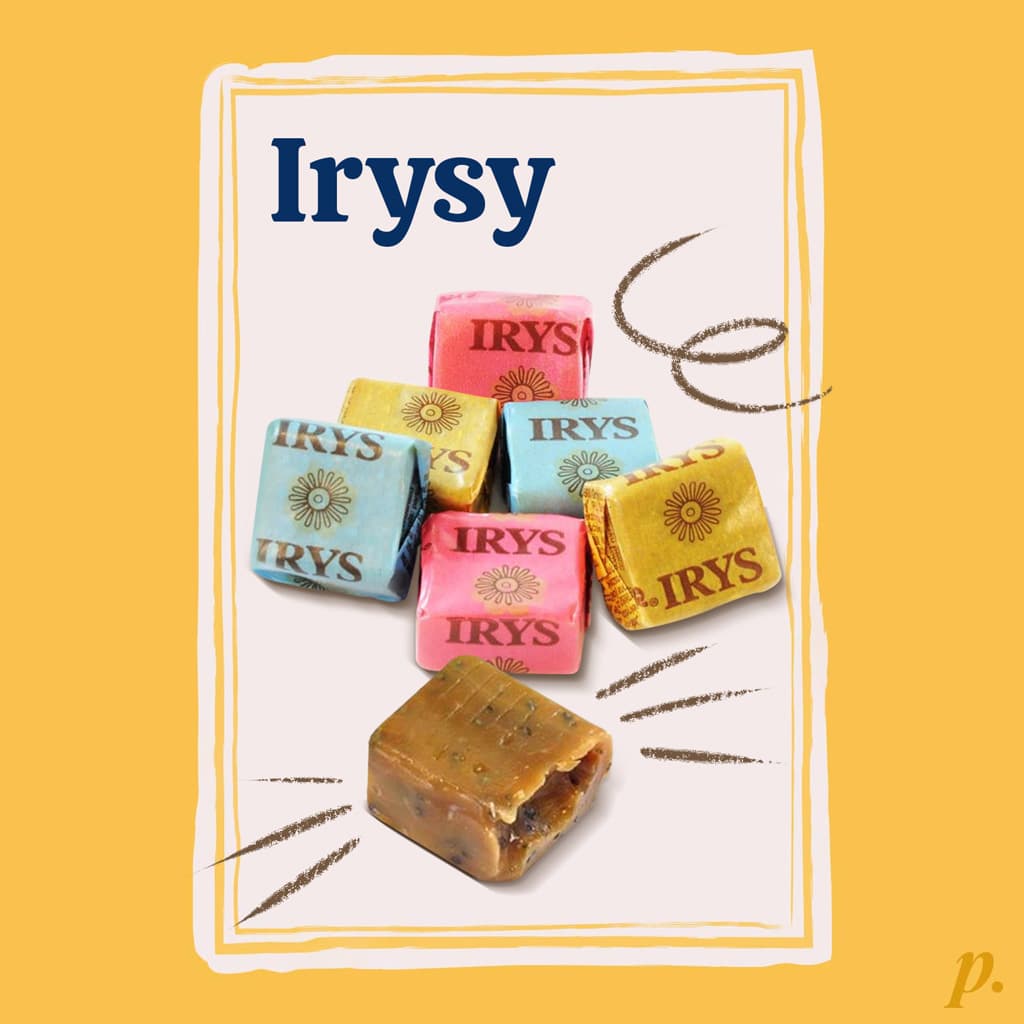
Despite being somewhat forgotten in recent years, ‘Irysy’ still evoke feelings of nostalgia for many Poles.
These cube-shaped milk caramels come in a variety of flavours, including cream, cocoa and poppy seed. And while ‘Irysy’ are somewhat similar to ‘Krówki’, they differ in texture – they’re more brittle and crumbly.
‘Irysy’ have been continuously produced since the interwar period, with their popularity peaking in the 1970s.
It’s likely that the name (perhaps also the recipe) for ‘Irysy’ came to Poland from Russia, where they are also a popular treat. According to a local legend, ‘Irysy’ were named by the French confectioner Morna (or Mornas), who worked in St. Petersburg at the turn of the 20th century. Supposedly, Morna noticed the similarity between the candies’ relief and the petals of the iris flower. However, I wasn’t able to find any historical sources to confirm this tale.
Despite their yumminess, ‘Irysy’ seem to have passed their heyday and are becoming increasingly difficult to find. However, they can still occasionally be found at some grocers, where they are sold in individual wrappers either by weight or in plastic bags. For those who crave a taste of nostalgia, the Irysy hunt is still worth undertaking.
Raczki
Pron.: ra-chkey; already plural
Manufacturers: Pszczółka, Wawel
‘Raczki’, which means ‘little crayfish’ in Polish, are delectable caramel sweets with a velvety nutty centre, infused with a delicate hint of rum. The confectionery’s name is derived from its stripy, red and white, crunchy outer layer that resembles crayfish.
Although the origin of Raczki is somewhat enigmatic, it is believed that they were initially produced at the Wawel (confectionery manufacturer) in Kraków.
Kukułki
Pron.: cuckoo-wkey; already plural
Manufacturers: Pszczółka, Wawel
‘Kukułki’, which means ‘cuckoos’ in Polish, are cocoa-flavoured caramels with a distinct white stripe encircling their hard and crunchy shell.
The interior of these sweets is soft, aromatic, and imbued with a subtle hint of alcohol. Although their flavour profile is similar to ‘Raczki’, the difference in colour is striking.
Remarkably, ‘Kukułki’ were easily obtainable during the communist era, even in the midst of the worst crises. It’s no wonder that they evoke nostalgia in many Poles.
Although ‘Kukułki’ contained alcohol, they were freely sold to children and weighed into paper cones by benevolent salespeople. Surprisingly, these candies are still used today to create a liqueur with the same flavour.
‘Kukułki’ are widely available at major grocery stores, and if you’re abroad, you can typically find them at Polish delicatessens.
Chocolate Candy Bars & Pralines
Danusia
Pron.: danoo-shia
Manufacturers: Wawel
‘Danusia’ is a Polish brand of thin chocolate bars, featuring a smooth filling made of semi-liquid chocolate and finely chopped peanuts, with a subtle alcoholic undertone.
‘Danusia’s’ origin story is quite charming. In the 1920s, Adam Piasecki, the then-owner of the Wawel chocolate factory, fell head over heels in love with an employee named Danuta (‘Danusia’ is a diminutive). He created the original recipe for this confectionery as an ode to her, even going so far as to adorn the packaging with her portrait.
‘Danusia’s’ bars weigh approximately 38 grams (1.35 oz) and are typically sold individually in shops and kiosks, often right next to the checkout counter.
Michałki
Pron.: me-how-key; already plural
Manufacturers: ZPC Śnieżka, Mieszko, Hanka Siemianowice, Wawel and others
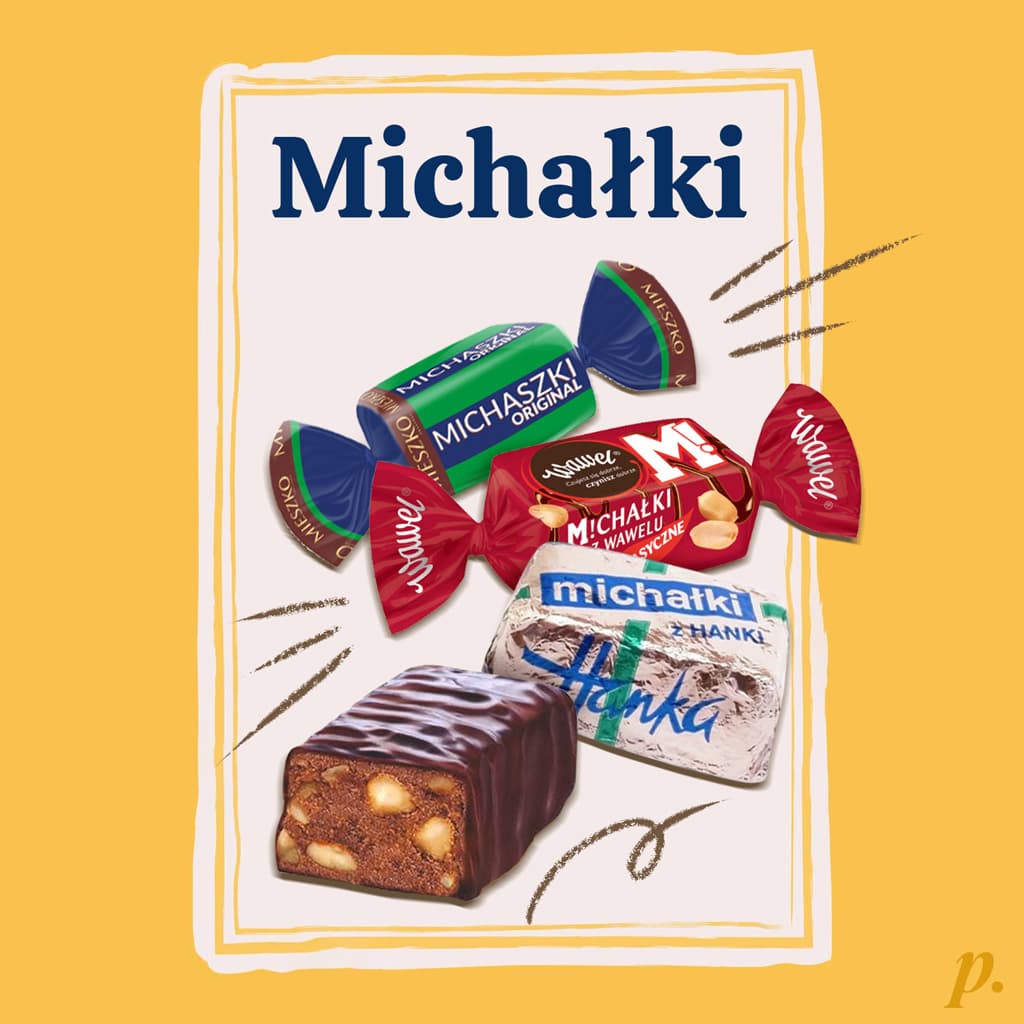
‘Michałki’ are chocolate-covered pralines with soft chocolate and peanut filling. These sweet treats are made by several manufacturers and are marketed under various names, including ‘Michaszki’ (both are the diminutive plural forms of the name ‘Michał’)
The renowned flavour of ‘Michałki’ was invented in 1967 by Janina Miodek, who served as the head of the food lab at the Śnieżka confectionery plant. Initially crafted by hand, ‘Michałki’ rapidly gained popularity and were regarded as a sign of wealth and prosperity. People even hung them on Christmas trees, by attaching a string to the wrapper.
Unlike some other sweets from that era that have become obsolete, ‘Michałki’ kept their place in our hearts, and in our tummies. Each bite-sized piece is individually wrapped, making them ideal for snacking and sharing. ‘Michałki’ can be purchased either by weight or in bags of varying sizes, wherever sweets are sold.
Malaga, Tiki-Taki & Kasztanki
Pron.: malaga, tiki-tacky, cash-tan-key; already plural
Manufacturers: Wawel
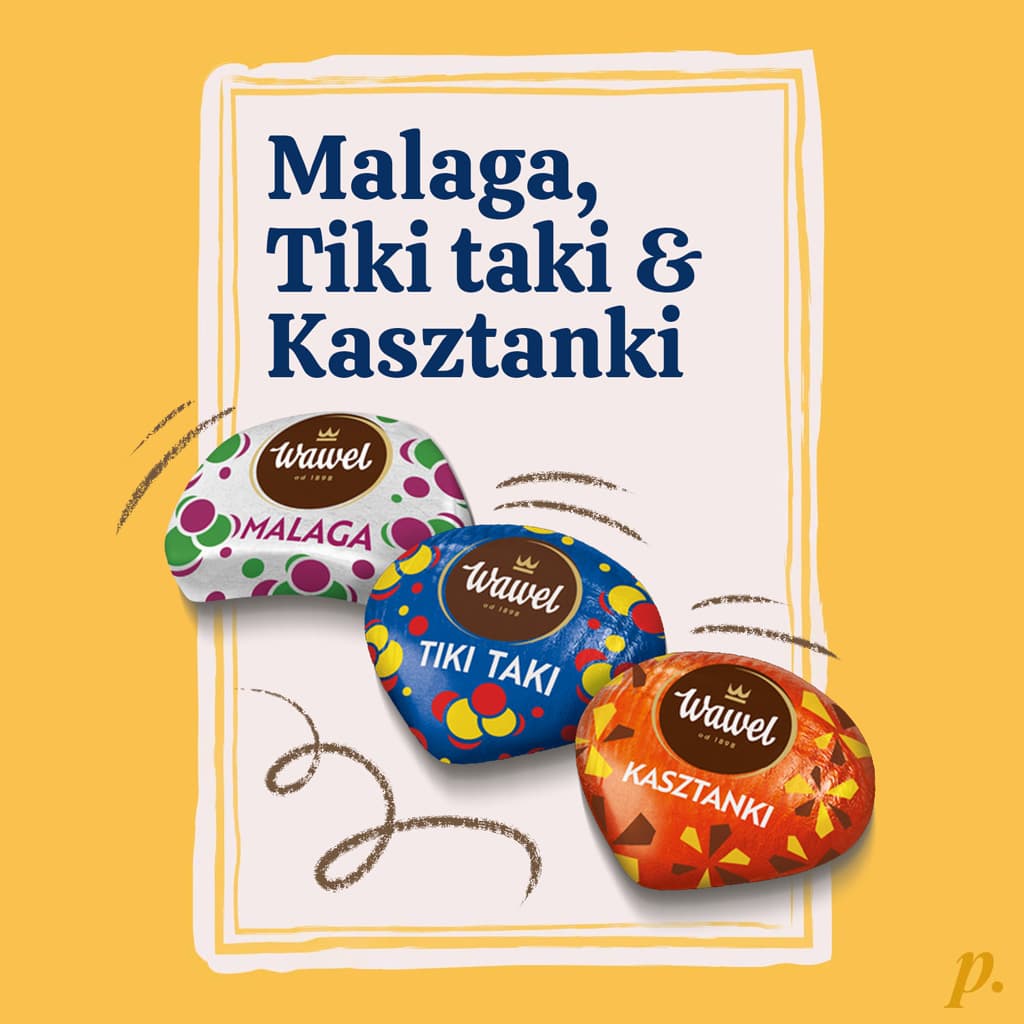
This family of pralines, though distinct from each other, belong together as a trio.
‘Malaga’ treats were first introduced in the late 1960s. They’re relatively large chocolate-covered pralines with a creamy filling enriched with raisins. Their name was inspired by the fortified dessert wine from the Spanish region of, you guessed it – Málaga.
Soon after, ‘Kasztanki’ became another bestseller. They’re filled with cocoa cream mixed with crunchy wafer chunks, and coated with a layer of dark chocolate. ‘Kasztanki’ were named after their chestnut-like shape, although some may see them more like shells.
The last one of this tasty trio is ‘Tiki Taki’, named after an old-fashioned toy you may recognise as ‘clackers’ or ‘click clacks’. ‘Tiki Taki’ have two semi-soft layers of filling, one with ground peanuts and the other with coconut shreds, hiding together under a coat of dark chocolate. Shape-wise, they look just like ‘Kasztanki’.
All three of these treats have individual wrappers and can be purchased by weight or in packs of varying sizes. They are relatively large for praline and require more than one bite to finish. Not that anyone complains…
Mieszanka Wedlowska
Pron.: myeah-SHAN-kah vedlov-skah
Manufacturers: E. Wedel (Lotte)
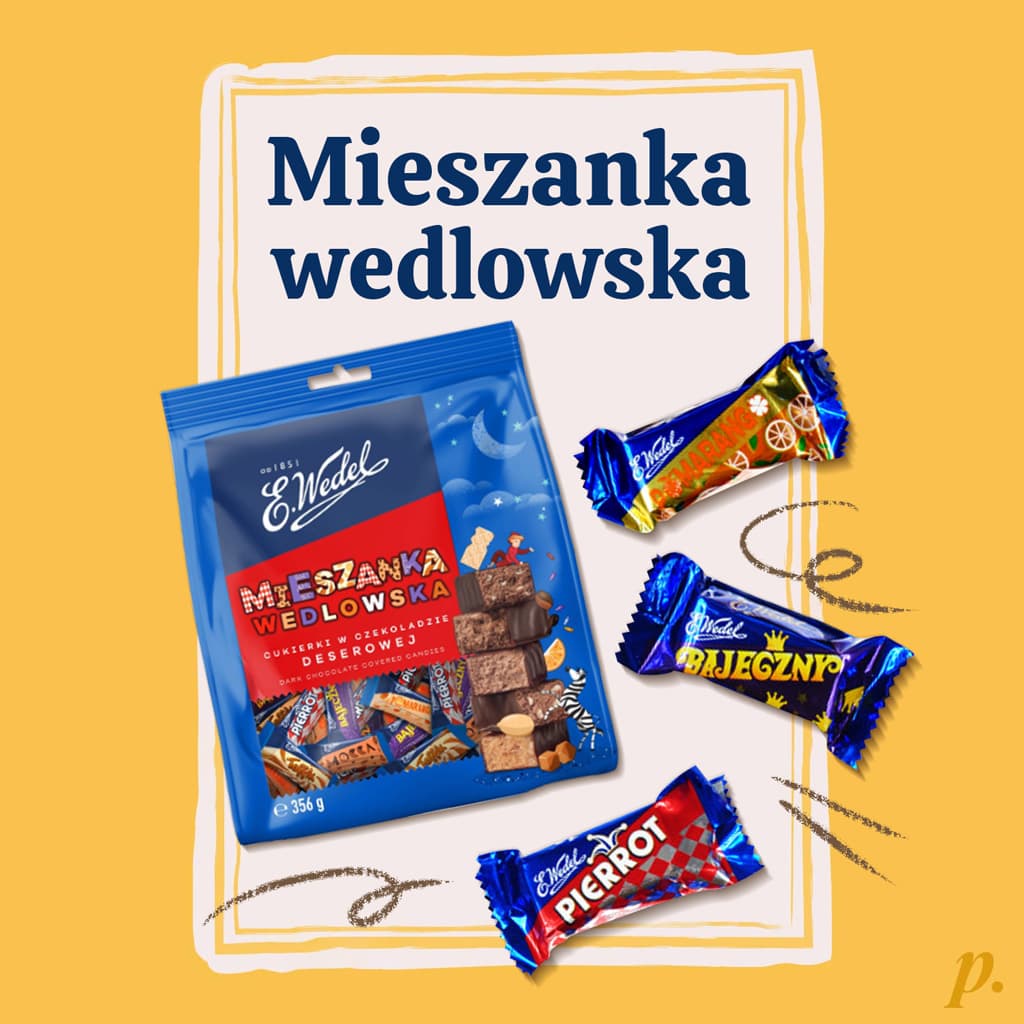
E. Wedel’s exclusive creation, the ‘Mieszanka Wedlowska’ or ‘Wedel’s assortment,’ is a collection of chocolate-coated pralines with a variety of fillings, each wrapped individually.
During the communist era, ‘Mieszanka’ became a coveted delicacy among many Poles, and it continues to hold a special place in their hearts to this day. It’s especially popular during Christmas as it served as a perfect complement to the primary gift.
Concept-wise, this confectionery has some similarities to Mars’ ‘Celebrations’ and Nestlé’s ‘Quality Street’.
‘Bajeczny’ and ‘Pierrot’ are two of the most popular flavours and are also available as bigger bars (slightly smaller than Snickers) and classic chocolate bars.
The core offering consists of:
Pierrot: semi-soft chocolate & ground peanut filling
Bajeczny: (meaning: mythical, fairytale-like) semi-soft ground roasted peanut & hazelnut filling
Depending on the collection, some of the other flavours include:
Irys: caramel & cream filling, similar to the legendary Irysy (mentioned earlier)
Paryski: (of Paris) orange jello
Wenecki: (of Venice) strawberry jello
Wiedeński: (of Vienna) cherry jello
Figiel: (meaning: trick) caramel & apple jello
Kawuś: (‘little Mr. Coffee’) coffee mousse
Toffik: (in the past named ‘Rekord’) toffee & ground wafer chunks
Tarragona: sangria-flavoured filling
Chocolate-Covered Wafers
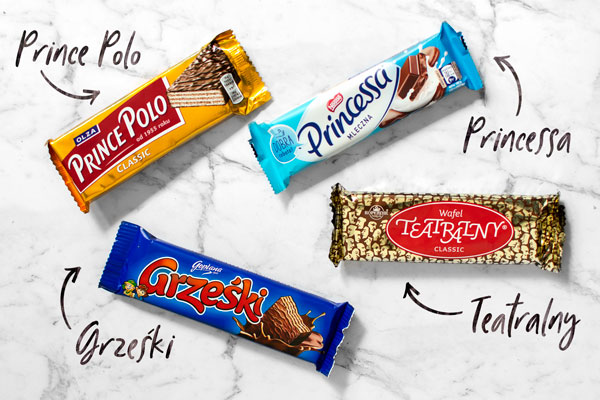
Prince Polo
Pron. varies: ‘prin-ceh polo’ or ‘price polo’, singular
Manufacturer: Olza (Mondelēz)
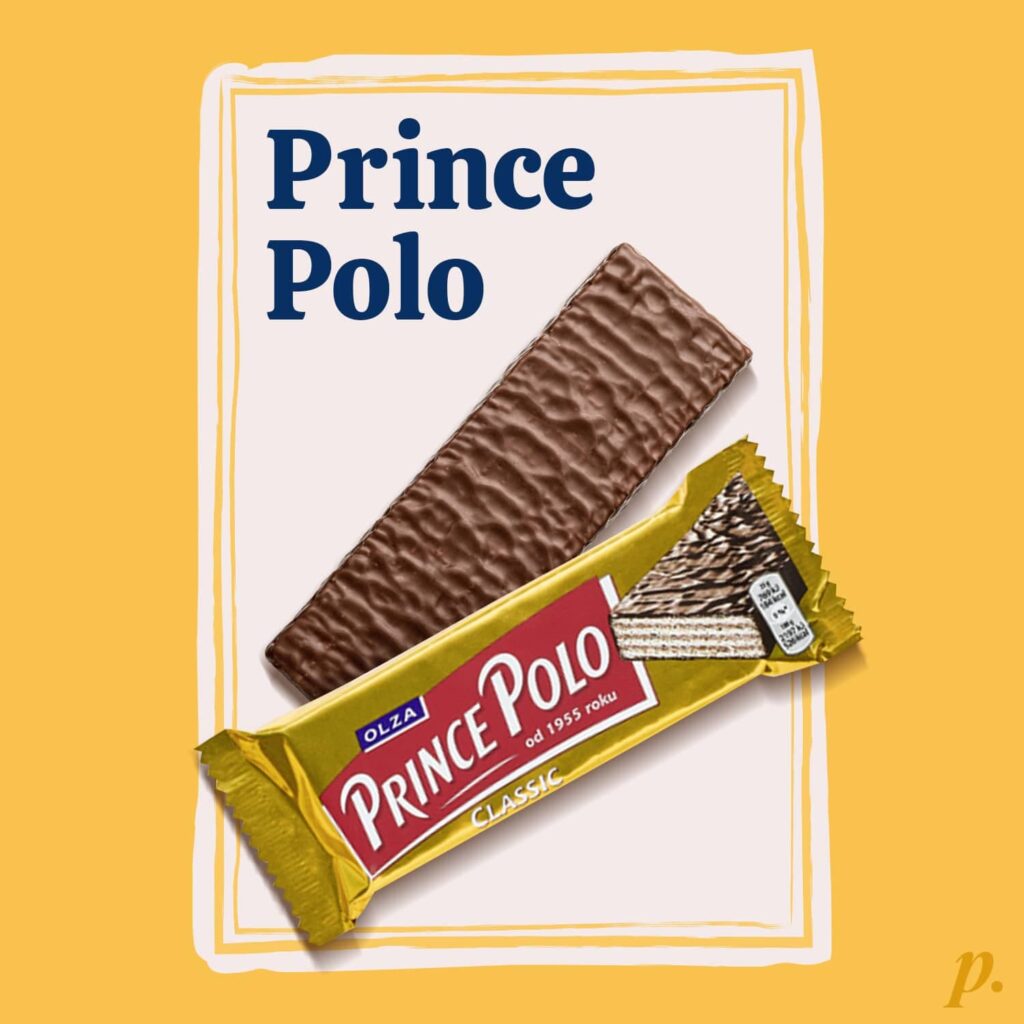
‘Prince Polo’ has stood the test of time as one of Poland’s oldest wafer brands, tracing back its roots to 1955 in Cieszyn.
What’s inside this iconic golden wrapper? Four layers of crispy wafer, intertwined with soft chocolate filling, all immersed in a dark chocolate glaze. It’s a simple concept, and yet so many competitors have failed to replicate its flavour.
In fact, ‘Prince Polo’ was such a hit export for Poland that when Iceland’s president, Ólafur Ragnar Grímsson, visited in 1999, he jokingly declared that “an entire generation of Icelanders grew up on two things – American Coca-Cola and Polish Prince Polo.”
‘Prince Polo’ is available in most shops and kiosks, frequently found near the checkout counter. The majority of Polish delis abroad carry it as well.
Princessa
Pron.: princessa, singular
Manufacturer: Nestlé
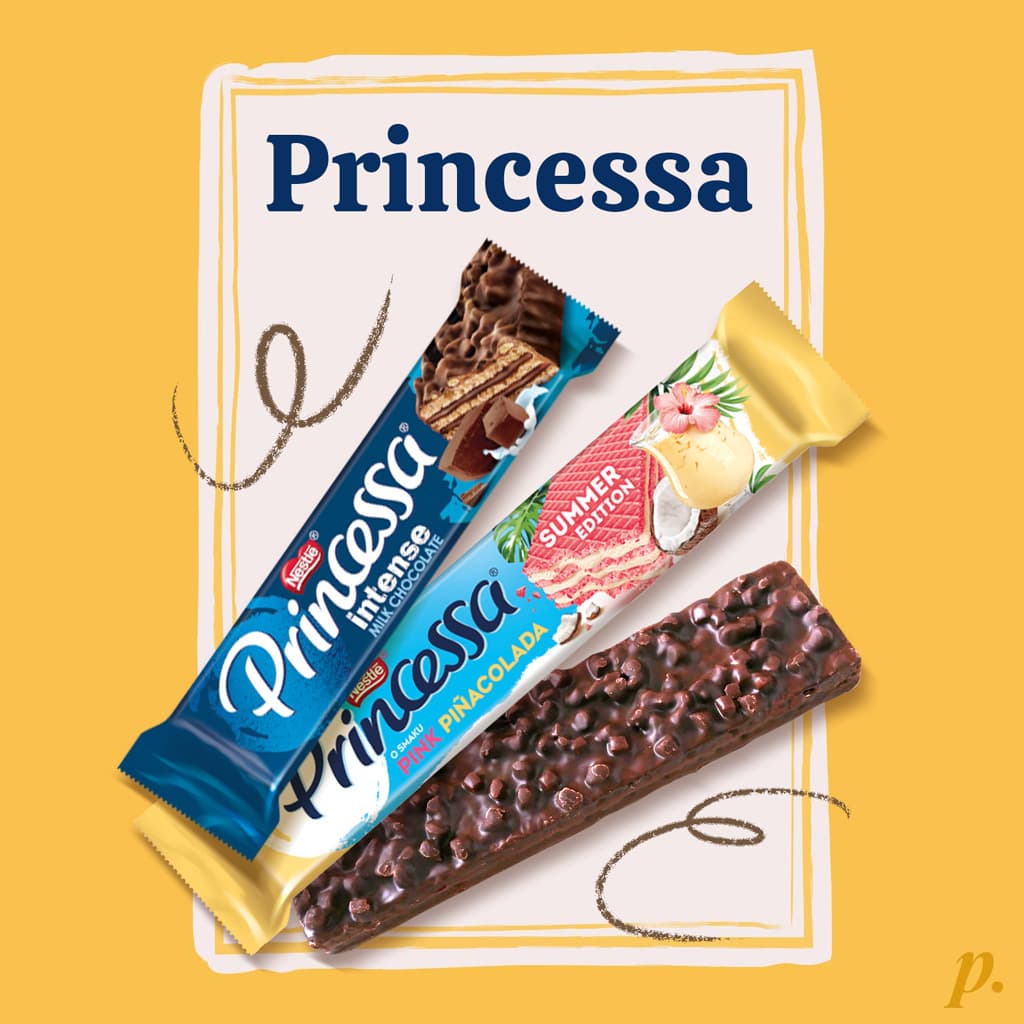
The regal name of ‘Princessa’ denotes its status as the counterpart to the ‘Prince Polo’ referenced above. It was originally produced by Goplana confectioneries in Poznań, but now finds itself among the vast Nestlé portfolio.
‘Princessa’ consists of a multi-layered wafer filled with an array of creams. While it offers three ‘core’ flavours – milk chocolate, hazelnut, and coconut – what truly sets this brand apart is its novel offerings, ranging anywhere from “brownie” and “salty caramel” to “strawberry smoothie”.
Year after year, ‘Princessa’ never fails to surprise with its latest additions to the flavour roster.
Grześki
Pron.: gsheh-shkey
Manufacturer: Goplana (Colian)
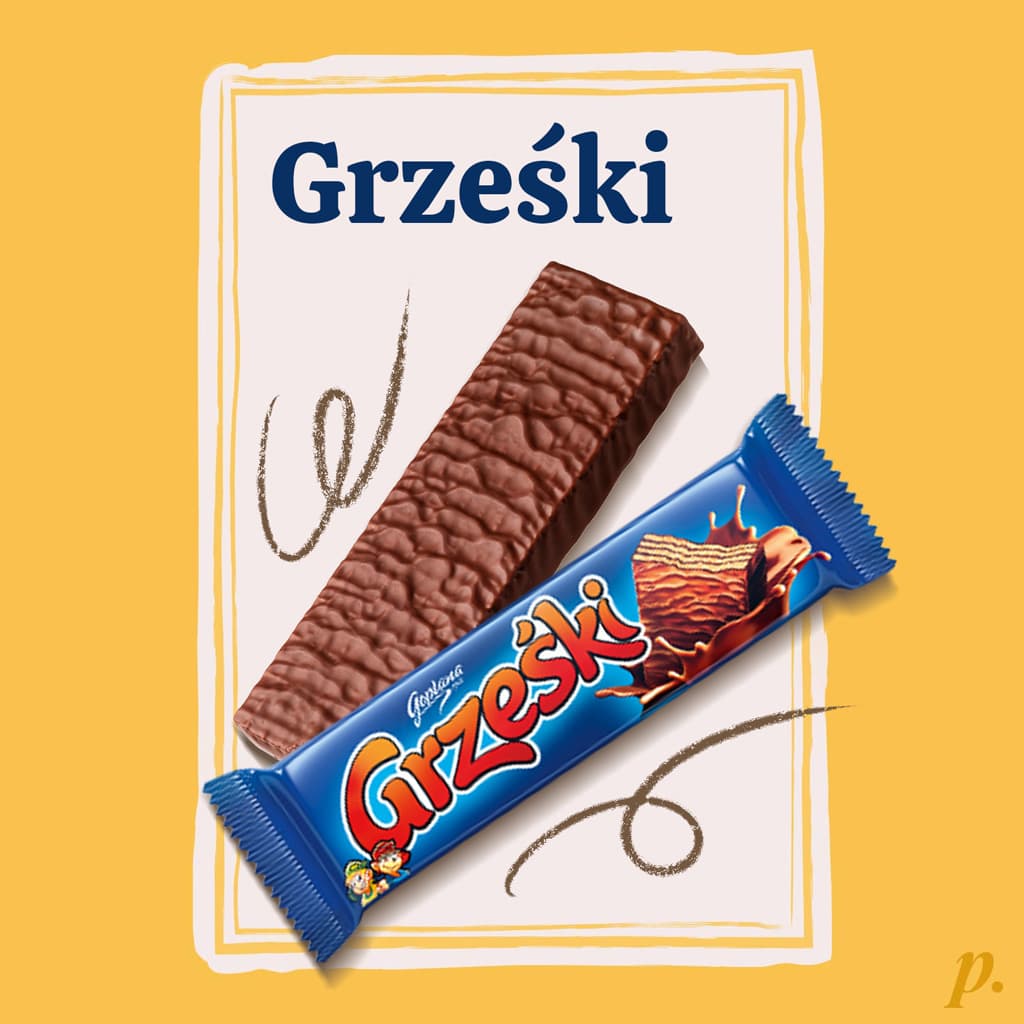
‘Grześki’ is a brand of chocolate-coated wafer bars layered with creamy cocoa filling. Although their taste may not earn any culinary accolades, the bars are pleasantly sweet and perfect for satisfying an unexpected sugar craving. Their fun branding and affordable nature make them a favourite among the younger crowd.
‘Grześki’ have been manufactured in the same factory in Kalisz since the very beginning. Their name is derived from the plural diminutive form of the Polish name Grzegorz. The reasons for choosing this name and the recipe origins remain a mystery.
In 2019, Polish-owned ‘Grześki’ replaced ‘Prince Polo’ as a sweet treat offered to the passengers of LOT Polish Airlines.
Teatralny
Pron.: te-atral-knee (to be improved, the “y” doesn’t sound exactly right)
Manufacturer: Kopernik
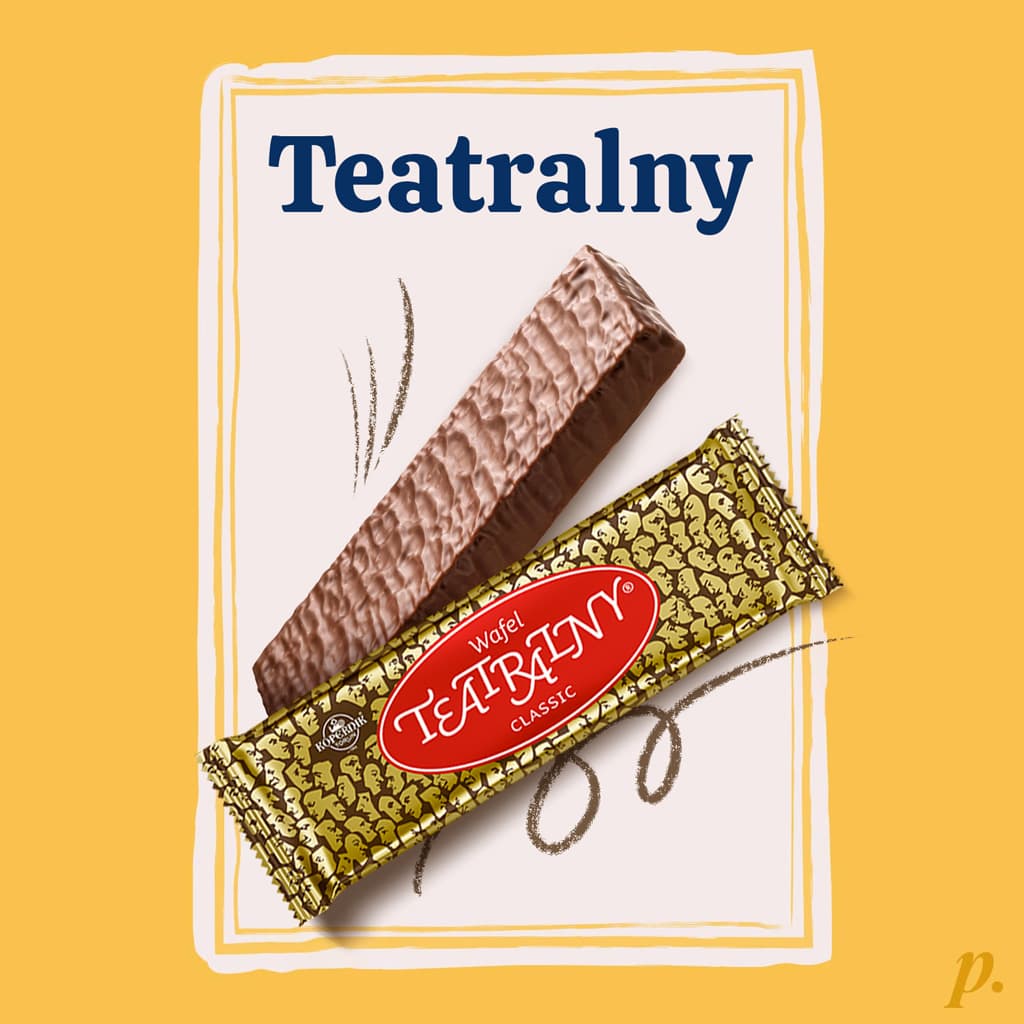
‘Teatralny’ (meaning ‘theatrical’) isn’t as dramatic as the name suggests. It’s simply composed of wafer layers filled with creamy goodness, all coated in chocolate.
Initially, only one flavour – classic nutty – was available, but now the range has expanded with chocolate and lemon cream options.
The wafer is produced at the oldest confectionery plant in Poland, established 260 years ago (back in 1763). The Toruń-based Kopernik factory is famous for its gingerbread cookies, which are a must-try delicacy.
What makes their ‘Teatralny’ stand out is its noticeably crispier and drier wafer texture, which some love and others may not – you’ll have to test it for yourself. It gets a stamp of approval from me.
Delicje Szampańskie
Pron.: delis-yeah sham-pañ-skieh, already plural
Manufacturer: Mondelēz, with others offering similar products under different brand names.
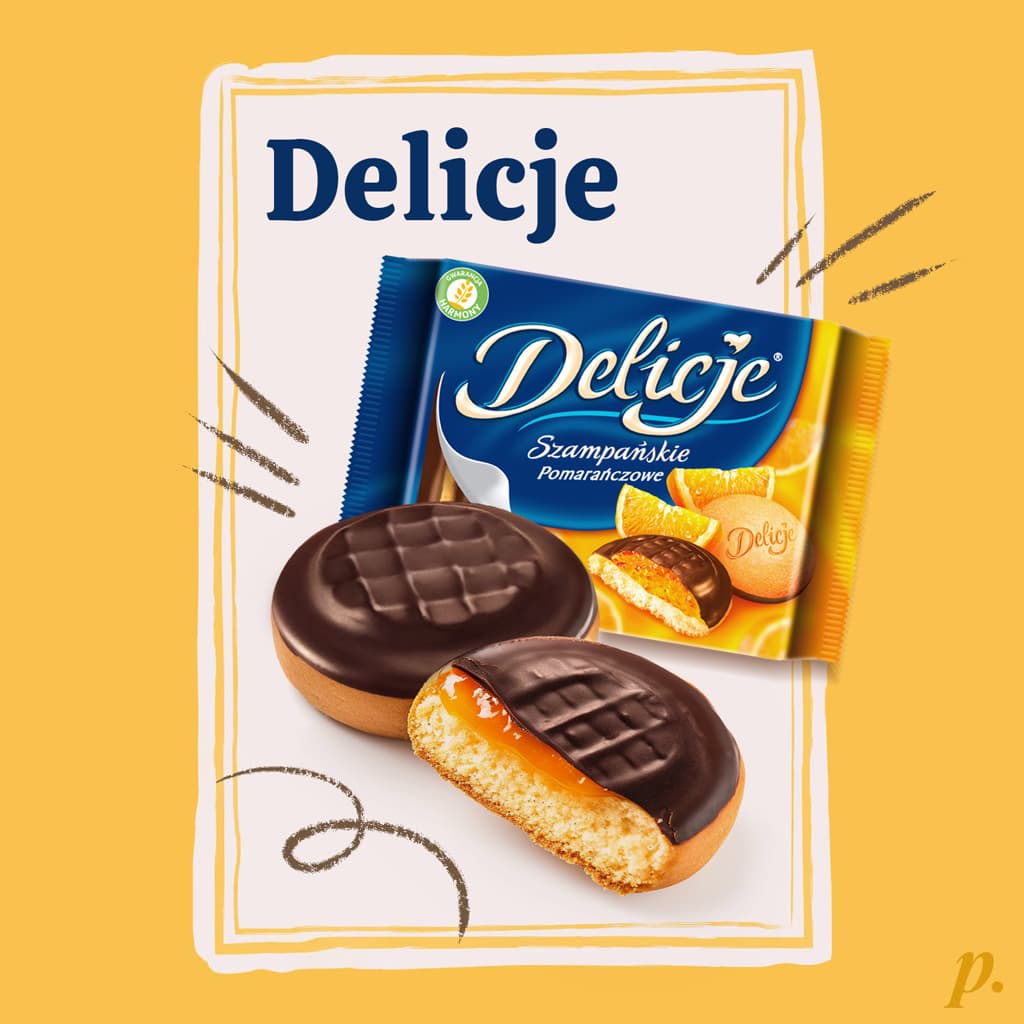
‘Delicje Szampańskie’, which means ‘champagne delicacies’ in Polish, are a type of jaffa-style cakes consisting of three delicious layers: a sponge base, a dollop of (originally) orange jam, and a layer of milk chocolate.
E. Wedel factory first made ‘Delicje’ in 1976 under a British license when oranges were scarce in communist Poland. To this day, many Poles mistakenly believe that ‘Delicje’ is a Polish invention.
Mondelēz, an international food giant, now produces ‘Delicje Szampańskie’ and offers them in various fruity flavours. E. Wedel also produces their own version under the name ‘Wedlowe,’ but there are also many more budget-friendly options to choose from.
Sezamki
Pron.: sezam-key, already plural
Manufacturers: Unitop (Majami), Odra, E. Wedel and many others
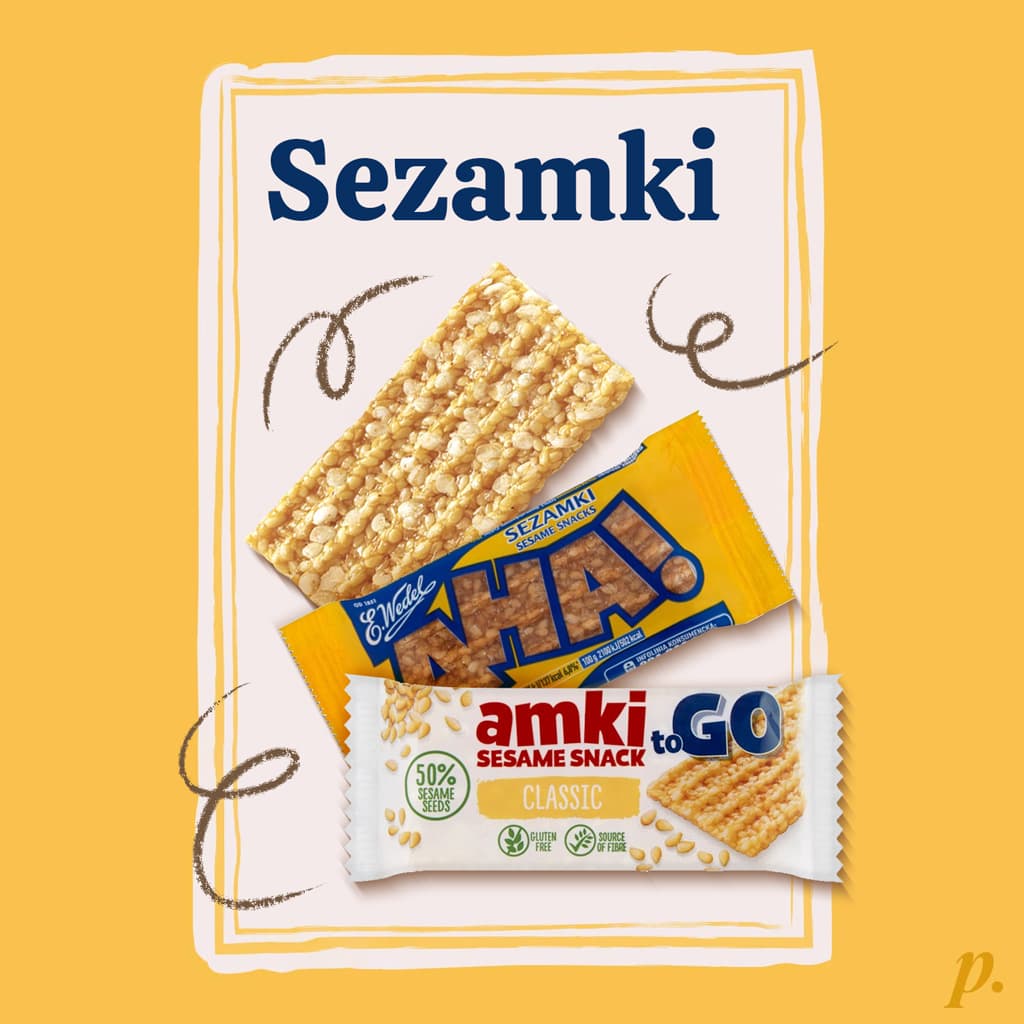
‘Sezamki’ are made by roasting sesame seeds and mixing them with sugar syrup, then pressed into thin bars. More indulgent versions are made with real honey, while sugar-free bars are sweetened with various sugar replacements.
While sesame seeds are not native to Poland, they have been a staple in Polish cuisine for centuries. Initially, it was a delicacy reserved for the nobility, but now it’s turned into a widely available and inexpensive snack.
The exact origin of pressing sesame seeds into bars is somewhat of a mystery, but ‘Sezamki’ has been around for decades. Unitop, based in Łódź, is Europe’s largest ‘Sezamki’ manufacturer and exports them worldwide. You may have come across them as ‘Sesame snaps’ or ‘Sesame thins’.
‘Sezamki’ is sold in petite packets, typically containing three or four thin bars, which is perfect for satisfying a sweet tooth without overindulging.
Pierniczki
Pron.: pierre-nitchkey, already plural
note: ‘Pierniki’ (pierre-nicky) is a broad term for all gingerbread (cookies AND cakes). The diminutive ‘Pierniczki’ is used just for cookies.
Manufacturers: Kopernik, Tago, Iga Sarzyńska, Ol’Vita, Pierniki Wrocławskie, Piernik Wrocławski, Skawa and others
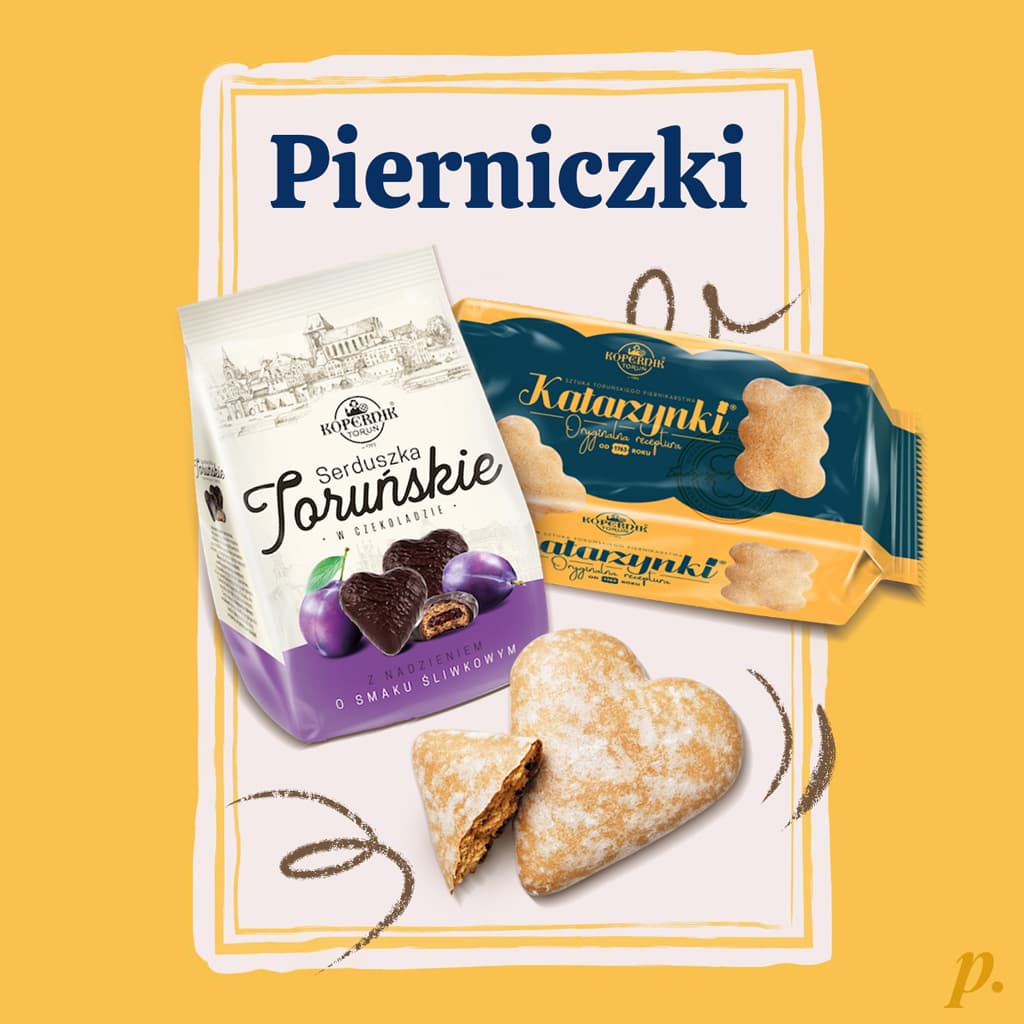
Although ‘Pierniczki’ are more closely related to cookies than candy & sweets, I have decided to mention them here.
‘Pierniczki’ come in a variety of shapes and sizes, and can be filled or coated, with varying textures from soft and clay-like to dry and crunchy. Every sweet-tooth has their own preference.
Traditionally, these sweet treats are made from flour, honey, and a blend of spices including pepper, cinnamon, cloves, nutmeg, anise, cardamom, coriander, and more. The proportions of these ingredients are often a closely guarded secret of every baker.
The first mention of gingerbread in Central Europe dates back to 1293, when it was baked in Lower Silesia. However, the strongest association with the Polish gingerbread tradition lies in the city of Toruń. It is here that most ‘Pierniczki’ are produced today, including those made by the ‘Kopernik’ factory, named after the famous Toruń dweller Copernicus.
‘Pierniczki’ can be found wherever sweets are sold. If you’re looking for a gift, consider seeking out hand-crafted artisan ones, which are definitely worth the extra few złoty. Alternatively, Kopernik offers ‘Pierniczki’ sets in lovely tins shaped like Toruń townhouses, most widely available during the festive season.
Torcik Wedlowski
Pron.: torchick vedlovsky
Manufacturer: E. Wedel (Lotte)
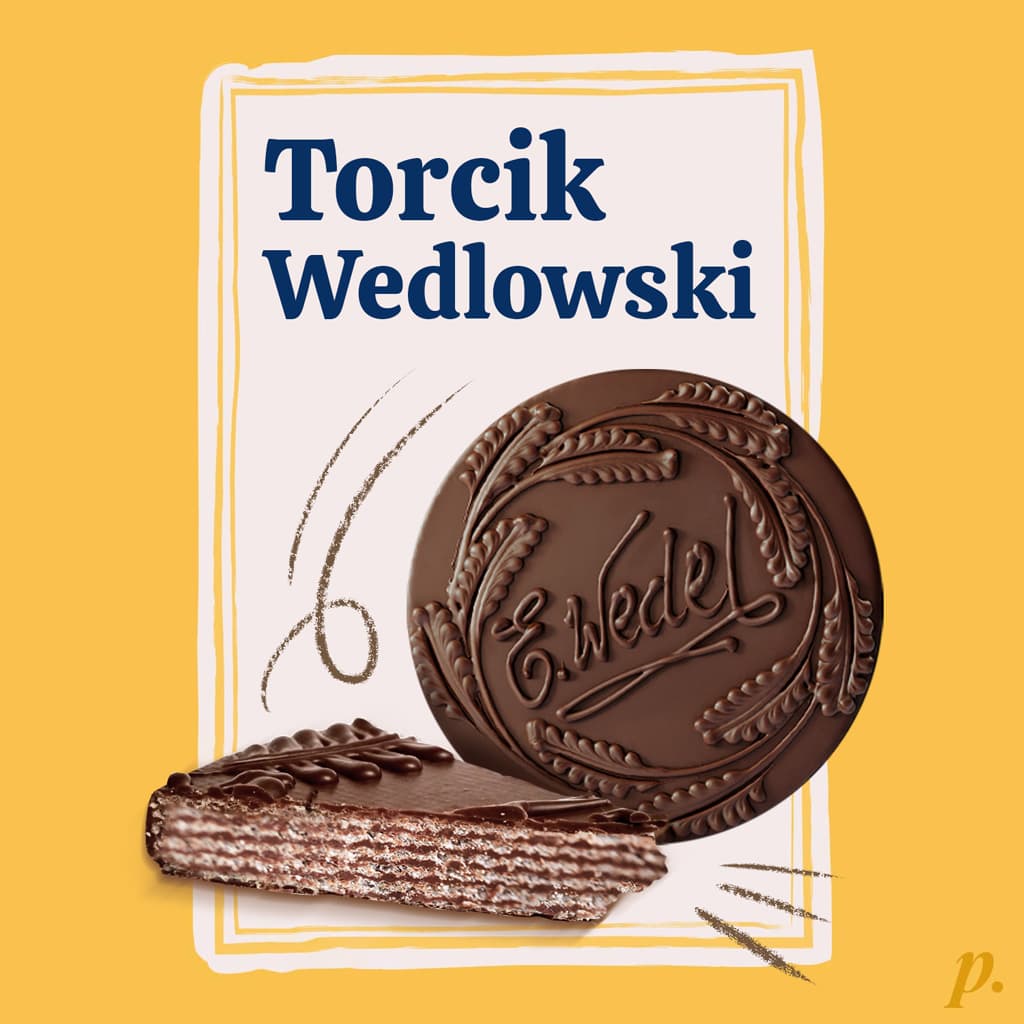
‘Torcik Wedlowski’ is a round wafer torte, filled with peanut cream and coated in dark chocolate. Its top is adorned with a stunning floral pattern and the signature of the founder, E. Wedel, in elegant calligraphy. Due to its handmade nature, no two tortes are identical.
The smallest ‘Torcik’ weighs 250 grams (equivalent to almost 9 ounces) and is meant for sharing. If you’d like to order one with a personalised message, simply place an order at one of Wedel’s chocolate lounges, and it will be ready within a couple of days.
Where to buy Polish sweets?
While most of the treats mentioned above are easily found throughout Poland – in kiosks, convenience stores, supermarkets, and online – internationally, it’s best to start by checking your local Polish deli.
In the UK, larger supermarkets such as Tesco and Sainsbury’s often have a dedicated ‘Polish aisle’ stocked with a range of tempting treats.
Polish sweet tooth has been globally recognised, with exports in 2021 alone totalling a sweet 4.1 billion euros, ranking us as the 7th largest exporter of such delights in the world (source 6).
If you’re still struggling to find your desired snack, don’t hesitate to ask that your local store stocks a range of Polish sweets. Even if it doesn’t work out, you’ll be raising awareness of our remarkable products among storekeepers worldwide.
Wrapping up (pardon the pun)
While I’ve already shared with you some of the most popular classics, it’s important to note that the world of Polish confectionery is as extensive as it is indulgent. Every year, this market churns out an incredible range of innovative treats that’ll make your taste buds sing.
Regrettably, several of the esteemed Polish brands have been acquired by large international corporations. Though most of their products are still made solely in Poland, the quality tends to suffer as a result (anecdotally or factually – it is hard to determine).
To help you identify the Polish-owned manufacturers, I have listed a number of them below, so you can make informed shopping decisions and support Polish enterprises.
Alongside the big players, there are plenty of small-scale artisanal confectioneries crafting mouth-watering delights using only the finest ingredients. It’s worth seeking them out during your next visit.
Disclaimer: This article wasn’t sponsored by any brand, all opinions expressed are solely my own.
